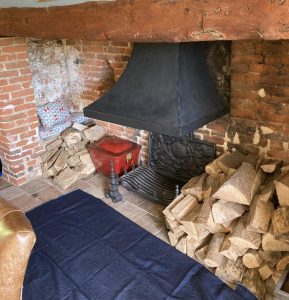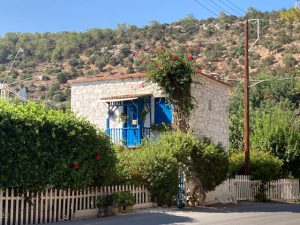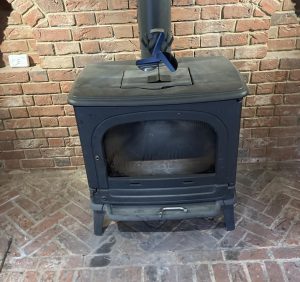
I usually associate Krog Iversen Scan stoves with large contemporary cylindrical stoves, which are the only type I have come across on my travels around the local area. Indeed, if you were to take a look at the Krog Iversen Scan website the vast majority of stoves you will see are of the contemporary cylindrical type. So, in many ways this example of a Krog Iversen Scan DSA7 Wood-Burning Cassette Stove is something of an anomaly and is the only example I see in the area. As you can see this cassette stove is something of a monster, with a rather huge, capacious fire-box that I should imagine throws out a terrific amount of heat when alight. You can get a sense of this by looking at the fuel it uses, the massive split logs that can be seen underneath the stove in the photo. Needless to say, this stove is not in any ordinary small sitting room, but in a rather large barn conversion.
Scan stoves are a Danish stove company who commenced production in 1978.
Henning Krog Iversen founded the company Krog Iversen (later Scan A/S) in small premises in Odense. At the time it was quite ground-breaking to produce wood-burning stoves in steel sheet instead of cast iron, and there were not many demands concerning combustion technique and environmental protection. The first wood-burning stoves were no more than “oil drums” with doors, but at Krog Iversen we took pride in producing high-end designed pieces of warm furniture with advanced combustion technique right from the start.
All Krog Iversen scan stoves can be bought through licensed dealerships in the UK.
https://www.scan-stoves.co.uk/


 My name is Paddy McKeown, I am a retired police officer (Detective Sergeant – Metropolitan Police), turned chimney sweep. I have completed training with ‘The Guild of Master Chimney Sweeps’, and Rod Tech UK (Power Sweeping).
My name is Paddy McKeown, I am a retired police officer (Detective Sergeant – Metropolitan Police), turned chimney sweep. I have completed training with ‘The Guild of Master Chimney Sweeps’, and Rod Tech UK (Power Sweeping).












 Yes, I’m still going on about my 60th birthday this month. I just wanted to show everyone this card with chimney sweeps on it that was made by our dearest friend Netty Patterson. I think everyone can agree that it is absolutely fantastic! Netty is so artistically gifted, a brilliant birthday surprise that must have taken a lot of time and concentration to make. Thank you Netty, I was deeply touched!
Yes, I’m still going on about my 60th birthday this month. I just wanted to show everyone this card with chimney sweeps on it that was made by our dearest friend Netty Patterson. I think everyone can agree that it is absolutely fantastic! Netty is so artistically gifted, a brilliant birthday surprise that must have taken a lot of time and concentration to make. Thank you Netty, I was deeply touched!





 DRU is a modern company that continues to specialise in producing gas heating appliances. It is the largest producer of balanced flue gas fires and wall heaters in Europe and also produces wood and multi-fuel stoves and fires.
DRU is a modern company that continues to specialise in producing gas heating appliances. It is the largest producer of balanced flue gas fires and wall heaters in Europe and also produces wood and multi-fuel stoves and fires.








